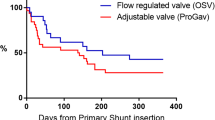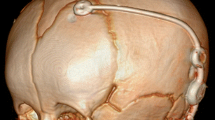Abstract
Background
Neonates represent a unique group of pediatric patients with special peculiarities. Hydrocephalus valves have not always been designed to meet the requirements of these small children. Few series have addressed the problem of cerebrospinal fluid shunting in newborn babies.
Objectives
We aimed (1) to evaluate the feasibility of the use of two programmable valves (Sophy and Polaris) in hydrocephalic neonates and (2) to ascertain complications and safety issues arising from their use.
Materials and methods
We performed a prospective study of 100 consecutive preterm and term babies (<2 months of age) given a programmable valve. Valves’ settings were readjusted at different pressure levels as required. Outcomes were obtained from the records of our Outpatient Clinic.
Results
The study group was formed by 60 term and 40 preterm infants (average weight 2,440 g, mean age of 25 days). Mean follow-up was 55 months. Only one fifth deaths was shunt-related. In 70 babies, no complications occurred, and hydrocephalus was successfully controlled. Proximal catheter obstruction presented in 20% and infection in 5% of cases. Several external adjustments of the valves apparently avoided several surgical shunt revisions.
Conclusions
(1) Both programmable valves (Sophy and Polaris) can be safely used for treatment of neonatal hydrocephalus, introducing some technical modifications. (2) Both valves are comparable to other shunts with regard to indications, performance, and safety. (3) The possibility of modifying their working pressure seems to constitute their main advantage. Prevention of late overdrainage syndromes with these valves needs a longer follow-up.



Similar content being viewed by others
References
Ahn ES, Bookland M, Carson BS, Weingart JD, Jallo GI (2007) The Strata programmable valve for shunt-dependent hydrocephalus: the pediatric experience at a single institution. Childs Nerv Syst 23:297–303
Aihara N, Tagaki T, Hashimoto N, Fukushima T, Karasawa K, Fuse T (1997) Breakage of shunt devices (Sophy programmable pressure valve) following implantation in the hypochondria region. Childs Nerv Syst 13:636–638
Anderson RCE, Walker ML, Viner JM, Kestle JRW (2004) Adjustment and malfunction of a programmable valve after exposure to toy magnets. J Neurosurg (Pediatrics 2) 101:222–225
Arnell K, Eriksson E, Olsen L (2006) The programmable adult Codman Hakim valve is useful even in very small children with hydrocephalus. A 7 year retrospective study with special focus on cost/benefit analysis. Eur J Pediatr Surg 16:1–7
Bret Ph, Guyotat J, Ricci AC, Mottolese C, Jouanneau E (1999) Expérience clinique de la valve réglable Sophy® dans le traitement de l’hydrocéphalie de ládulte. Une série de 147 cas. Neurochirurgie 45:98–109
Bruisma N, Stobbering EE, Herpers MJHM, Vies JSH, Weber BJ, Gavilanes DAWD (2000) Subcutaneous ventricular catheter reservoirs and ventriculo-peritoneal drain related infections in preterm infants and young children. Clin Microbiol Infect 6:202–206
Carmel PW, Albright L, Adelson D, Canady A, Black P, Boydston W et al (1999) Incidence and management of subdural hematoma/hygroma with variable- and fixed-pressure differential valves: a randomized, controlled study of programmable compared with conventional valves. Neurosurg Focus 7(4): article 7
Ceddia A, Di Rocco C, Iannelli A, Lauretti L (1992) Idrocefalo neonatale ad eziologia non tumorale. Risultati del trattamento chirurgico nel primo mese di vita. Minerva Pediatr 44:445–450
Czosnyka Z, Czosnyka M, Coperman J, Pickard JD (2000) A randomized, controlled study of a programmable shunt valve versus a conventional valve for patients with hydrocephalus (letter). Neurosurgery 47:1250–1251
Czosnyka Z, Czosnyka M, Richards HK, Pickard JD (1998) Posture-related overdrainage: comparison of the performance of 10 hydrocephalus shunts in vitro. Neurosurgery 42:327–334
Di Rocco C, Marchese E, Velardi F (1994) A survey of the first complication of newly implanted CSF shunt devices for the treatment of nontumoral hydrocephalus: cooperative survey of the 1991–1992 Education Committee of the ISPN. Childs Nerv Syst 10:321–327
Di Rocco C, Massimi L, Tamburrini G (2006) Shunts vs endoscopic third ventriculostomy in infants: are there different types and/or rates of complications. A review. Childs Nerv Syst 22:1573–1589
Drake JM, Kestle JR, Milner R, Cinalli G, Boop F, Piatt J Jr et al (1998) Randomized trial of cerebrospinal fluid shunt valve design in pediatric hydrocephalus. Neurosurgery 43:294–305
Eymann R, Steudel WI, Kiefer M (2007) Pediatric gravitational shunts: initial results from a prospective study. J Neurosurg (s Suppl Pediatrics) 106:179–184
Frim DM, Lahtrop D (2000) Telemetric assessment of intracranial pressure changes consequent to manipulations of the Codman–Medos programmable shunt valve. Pediatr Neurosurg 33:237–242
Hamid NA, Sgouros S (2005) The use of an adjustable valve to treat overdrainage of a cyst-peritoneal shunt in a child with a large sylvian fissure arachnoid cyst. Childs Nerv Syst 21:991–994
Inoue T, Kuzu Y, Ogasawara K, Ogawa A (2005) Effect of 3-Tesla magnetic resonance imaging on various pressure programmable shunt valves. J Neurosurg (Pediatrics 2) 103:163–165
Jandial R, Aryan HE, Hughes S, Levy ML (2004) Effect of vagus nerve stimulator magnet on programmable shunt settings. Neurosurgery 55:627–630
Kamiryo, T, Fujii I, Kusaka M, Kashinagi S, Ito H (1991) Intracranial pressure monitoring using a programmable pressure valve and a telemetric intracranial pressure sensor in a case of slit ventricle syndrome after multiple shunt revisions. Childs Nerv Syst 7:233–234
Kestle JRW, Walker ML, for the Strata investigators (2005) A multicenter prospective cohort study of the Strata valve for the management of hydrocephalus in pediatric patients. J Neurosurg (Pediatrics 2) 102:141–145
Kondageski C, Thompson D, Reynolds M, Hayward RD (2007) Experience with the Strata valva in the management of shunt overdrainage. J Neurosurg (2 Suppl Pediatr) 106:95–102
Korinth MC, Weinzierl MR, Gilsbach JM (2003) Experience with a new concept to lower non-infectious complications in infants with programmable shunts. Eur J Pediatr Surg 13:81–86
Liptak GS, McDonald JV (1985/86) Ventriculoperitoneal shunts in children: factors affecting shunt survival. Pediatr Neurosci 12:289–293
Lüdemann W, Rosahl SK, Kaminsky J, Samii M (2005) Reliability of a new adjustable shunt device without the need of readjustment following 3-Tesla MRI. Childs Nerv Syst 21:227–229
Lumenta CB, Skotarczak U (1995) Long-term follow-up in 233 patients with congenital hydrocephalus. Childs Nerv Syst 11:173–175
Lumenta CB, Roosen N, Dietrich W (1994) Clinical experience with a pressure adjustable Sophy valve in the management of hydrocephalus. Childs Nerv Syst 6:270–274
Mangano FT, Menendez JA, Habrock T, Narayan P, Leonard JR, Park TS et al (2005) Early programmable valve malfunctions in pediatric hydrocephalus. J Neurosurg 103(6 Suppl Pediatrics):501–507
McGirt MJ, Back DW II, Sciubba D, Woodworth GF, Carson B, Weingart J et al (2007) Adjustable vs set-pressure valves decrease the risk of proximal shunt obstruction in the treatment of pediatric hydrocephalus. Childs Nerv Syst 23:289–295
Miwa K, Kondo H, Sakai N (2001) Pressure changes observed in the Codman–Medos programmable valves following magnetic exposure and filliping. Childs Nerv Syst 17:150–153
Nomura S, Fujisawa H, Suzuki M (2005) Effect of cell phone magnetic fields on adjustable cerebrospinal fluid shunt valves. Surg Neurol 63:467–468
Oi S, Matsumoto S (1989) Hydrocephalus in premature infants. Characteristics and therapeutic problems. Childs Nerv Syst 5:76–82
Ortler M, Kostron H, Felber S (1997) Transcutaneous pressure-adjustable valves and magnetic resonance imaging: an ex-vivo examination of the Codman–Medos programmable valve and the Sophy adjustable pressure valve. Neurosurgery 40:1050–1058
Peña C, Bowsher K, Samuels-Reid J (2004) FDA-approved neurologic devices intended for use in infants, children and adolescents. Neurology 63:1163–1167
Pezzotta S, Locatelli D, Bonfanti N, Sfogliarini R, Bruschi L, Rondini G (1987) Shunt in high-risk newborns. Childs Nerv Syst 3:114–116
Pollack I, Albright A, Adelson P, The Hakim-Medos Investigator Group (1999) A randomized controlled study of a programmable shunt valve versus a conventional valve for patients with hydrocephalus. Hakim–Medos Investigator Group. Neurosurgery 45:1399–1411
Reinprecht A, Dietrich W, Bertalanffy A, Czech T (1995) The Medos–Hakim programmable valve in the treatment of pediatric hydrocephalus. Childs Nerv Syst 13:588–594
Ringel F, Schramm J, Meyer B (2005) Comparison of programmable shunt valves vs. standard valves for communicating hydrocephalus of adults: a retrospective analysis of 407 patients. Surg Neurol 63:36–41
Robinson S, Kaufman BA, Park TS (2002) Outcome analysis of initial neonatal shunts: does the valve make a difference? Pediatr Neurosurg 37:287–294
Rohde V, Mayfrank L, Ramakers VTh, Gilsbach JM (1998) Four-year experience with the routine use of a programmable Hakim valve in the management of children with hydrocephalus. Acta Neurochir (Wien) 140:1127–1134
Rohde V, Weinzzierl M, Mayfrank L, Gilsbach JM (2002) Postshunt insertion CSF leaks in infants treated by an adjustable valve opening pressure reduction. Childs Nerv Syst 18:702–704
Sato K, Shimizu S, Utsuki S, Suzuki S, Oka H, Fujii K (2006) Disparity between adjusted and actual opening cerebrospinal fluid pressure in a patient with the Codman–Hakim programmable valve: occult form of shunt failure due to head banging. Case report. J Neurosurg (5 Suppl Pediatrics) 105:425–427
Schneider T, Knauff U, Nitsch J, Firsching R (2002) Electromagnetic field hazards involving adjustable shunt valves in hydrocephalus. J Neurosurg 96:331–334
Shimizu S, Utsuki S, Suzuki S, Oka H, Fujii K (2005) Obstruction of a Codman–Hakim programmable valve by a migrating pressure control cam. J Neurosurg (Pediatrics 3) 103:270–271
Sutcliffe JC, Battersby RDE (1992) Do we need variable pressure shunts. Br J Neurosurg 6:67–70
Takahashi Y (2001) Withdrawal of shunt systems—clinical use of the programmable shunt system and its effect on hydrocephalus in children. Childs Nerv Syst 17:472–477
Tuli S, Drake J, Lawless J, Wigg M, Lamberti-Pasculli M (2000) Risk factors for repeated cerebrospinal shunt failures in pediatric patients with hydrocephalus. J Neurosurg 92:31–38
Utsuki S, Shimizu S, Oka H, Suzuki S, Fujii K (2006) Alterations of the pressure setting of a Codman–Hakim programmable valve by a television. Case report. Neurol Med Chir (Tokyo) 46:405–407
Warf BC (2005) Comparison of 1 year outcomes for the Chhabra and Codman–Hakim micro precision shunt systems in Uganda: a prospective study in 195 children. J Neurosurg (Pediatrics 4) 102:358–362
Yamashita N, Kamiya K, Yamada K (1999) Experience with a programmable valve shunt system. J Neurosurg 91:26–31
Zemark G, Bellner J, Siesjö P, Strömblad LG, Romner B (2003) Clinical experience with the use of a shunt with an adjustable valve in children with hydrocephalus. J Neurosurg 98:471–476
Acknowledgment
The authors state that they do not have financial or other type of interest in any of the valves mentioned in this study.
Author information
Authors and Affiliations
Corresponding author
Rights and permissions
About this article
Cite this article
Martínez-Lage, J.F., Almagro, MJ., del Rincón, I.S. et al. Management of neonatal hydrocephalus: feasibility of use and safety of two programmable (Sophy and Polaris) valves. Childs Nerv Syst 24, 549–556 (2008). https://doi.org/10.1007/s00381-007-0512-5
Received:
Published:
Issue Date:
DOI: https://doi.org/10.1007/s00381-007-0512-5




